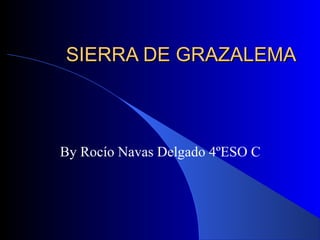Grazalema by rocio navas
- 1. SIERRA DE GRAZALEMA By Roc├Ło Navas Delgado 4┬║ESO C
- 2. Situation: It is situated between the North-East of the province of Cadiz and the northwest of the province of Malaga. Its surface area is 53.411 h
- 3. Climate and hydrology ’ü¼ In some points of the Sierra de Grazalema there is a registered rainfall of more than 2.200 mm, and so is the rainiest place in the south of Spain, in spite of the summer drought the area experiences. ’ü¼ There are three distinct watersheds: the rivers of the north zone flow into the river Guadalete, those of the East flow into the river Guadiaro and the rivers in the western part flow into the ŌĆ£Reservoir of the FerretsŌĆØ.
- 4. Landscapes
- 5. ’ü¼ Cave of the two doors
- 6. Vegetation ’ü¼ The most typical vegetation is the ŌĆ£pinsaparŌĆØ or forest of high local firs. Also we can find other vegetation of great value, such as groves of evergreen oaks, cork oaks & wild olive trees.
- 7. Flora ’ü¼ There is a wide variety of flowers in this nature reserve, including more than 1.375 species. This number represents slightly more than 25% of the species in Spain and more than 55 % of the species in Western Andalucia.
- 8. Fauna ’ü¼ There are more than 200 catalogued species of vertebrates: 7 species of fish, 34 of amphibians and reptiles, 44 species of mammals and more than 130 species of birds. Many of them are classed as protected species.
- 9. ’ü¼ La Sierra de Grazalema has one of the major colonies of griffon vultures in Europe and also some specimens of the Egyptian vulture, a seriously endangered species.
- 10. Cultural heritage ’ü¼ There is a long list of historical remains, such as Ocuri's Roman ruins and a rich variety of other archaeological remains (necropolis, aqueducts, Roman villas and causeways; medieval and Islamic remains, burial places, neolithic shelters, cave art, etc). Amongst buildings of popular architecture which stand out there are numerous hydraulic mills, though there are also brickworks, presses, oil-mills, ovens and public launderettes.
- 11. Roman causeways
- 12. Ocuri's ruins
- 13. Hydraulic mills
- 14. THE END













